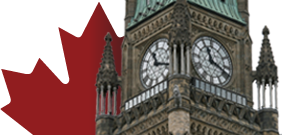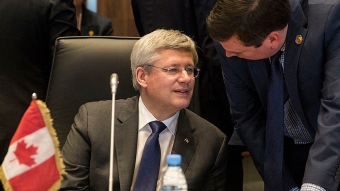
Prime Minister Harper’s private office in Centre Block is steeped in Canadian history. A portrait of Sir John A. Macdonald dominates the room. Prime Minister Harper often tells visitors that the Father of Confederation’s eyes seem to follow him as he goes about his duties. Mr. Harper, a Conservative, personally chose to place the portrait of Sir John A. in his office.
Canada’s Prime Ministers have hosted world leaders in 307-S such as U.S. Presidents Ronald Reagan, George Bush Sr., Bill Clinton, George W. Bush and Barack Obama. South Africa’s Nelson Mandela has visited this office, as did Prime Minister Margaret Thatcher of the United Kingdom. John Lennon of the Beatles met for 50 minutes with Canada’s Prime Minister here during a visit to Ottawa in 1969.
Prime Minister Sir Robert Borden first used this third-floor office in 1920, later handing over the keys to it to his successor, to his successor, the Right Honourable Arthur Meighen. When Liberal Mackenzie King became prime minister in 1921, he chose to remain in the Leader of the Opposition’s Office on the fourth floor. For almost 22-years, Mr. King worked as prime minister there. His successor, the Right Honourable Louis St. Laurent, did as well from 1948 until 1957.
Mr. King’s decision to remain on the fourth floor meant that Conservative leaders used 307-S for decades. Prime Minister R.B. Bennett, for example, worked from this room during the entire five years he was Prime Minister. He reportedly once telephoned one of his secretaries who worked from one of the adjoining offices. “Disguising his voice (Bennett) complained bitterly that he had tried repeatedly to see the Prime Minister,” recalled his assistant Andrew D. MacLean. “He thoroughly enjoyed his secretary’s explanation and discomfiture.”
A future Prime Minister, Brian Mulroney, had better luck trying to reach the Prime Minister by telephone. While a university student in the early 1960s he called the Prime Minister’s Office on a dare and was, to his own surprise, immediately connected to Prime Minister Diefenbaker.
Prime Ministers of Canada have used 307-S as their private office since Mr. Diefenbaker’s service as the 13th Prime Minister between 1957 and 1963 – with one exception. The Right Honourable Joe Clark, who was Prime Minister in 1979-1980, chose to remain in the fourth floor office used by Prime Ministers King and St. Laurent.
Prime Minister Harper has brought an important new feature to the corridor outside of 307-S. Working with historians and curators, he has made this area a showcase of Canadian history. In 2012 original artefacts related to the early fur trade in Canada were proudly displayed. Arctic explorer Sir John Franklin was remembered in the next exhibition. Additional displays are planned.
Canada’s prime ministers have not always worked out of a private office in the Centre Block. The second Prime Minister, the Hon. Alexander Mackenzie , who served from 1873 to 1878, chose to locate his office in the West Block. He installed a secret staircase which connected directly to his room. This allowed him to leave work and avoid the office seekers who often crowded his outer office.
After the fire of 1916 destroyed the Centre Block, sessions of the House of Commons were held at what is now Canada’s Museum of Nature. Prime Minister Sir Robert Borden had a private office at this location. Located on the museum’s third floor it was removed in 2010 as it did not meet modern safety codes.
From Sir John A. Macdonald to Pierre Trudeau, Canada’s prime ministers also had a working office located on the second floor of the East Block. It was here that Prime Ministers guided and shaped Canada during our nation’s early days. Cabinet also met in East Block and issues of war and peace, national unity, the building of the transcontinental railway and so much more were debated in the original Privy Council chamber.
Stories arising from the East Block’s unique connection to the Office of the Prime Minister are legion. On his first day as Prime Minister of Canada in 1948, Louis St. Laurent worked late. The winter’s darkness had descended on Ottawa. He left for home around 8 p.m.
Upon arriving at the elevator the Prime Minister was greeted by the elevator operator. With the building deserted, St. Laurent asked the man why he was still on duty. The operator replied that it was custom to remain at his post until Canada’s Prime Minister had departed each day.
“This will be the last time,” St. Laurent said. “I can still walk down one flight of stairs. From now on you will leave at the end of regular hours of work.”
It was also in the East Block office that Prime Minister John Diefenbaker had a large blue marlin fish installed ahead of U.S. President John F. Kennedy’s 1961 visit to Ottawa. Mr. Diefenbaker had previously met President Kennedy at the White House and the pair traded fishing stories. Legend has it that President Kennedy doubted that Canada’s leader had truly landed a large blue marlin. Mr. Diefenbaker would not let this stand. He therefore made sure the blue marlin he had caught, off Jamaica, during a 1961 holiday, was properly stuffed and on display in his private East Block when he and President Kennedy met there on May 17, 1961.
“As the President entered the room,” Prime Minister Diefenbaker’s foreign policy assistant, H. Basil Robinson, later wrote, “the Prime Minister made a point of displaying the mounted marlin he had landed during the winter holiday in Jamaica … Having been educated, the President, wearing a fading tan and looking a little tired, declared himself ready.”
This noble fish can be seen today at the Diefenbaker-Canada Centre at the University of Saskatchewan in Saskatoon.
Prime Minister Trudeau’s working office was re-located to the Langevin Block, across the street, in the early 1970. Prime Ministers ever since, with the exception of the Right Honourable Jean Chretien from 1993 and 2003, have maintained a private working office in the Langevin Block. Prime Minister Chretien preferred to work exclusively in Centre Block.
Sources:
References used for this section include conversations between the Prime Minister’s Office speechwriter, Arthur Milnes, and Richard Gwyn, Brian Mulroney and Maria K.Somjen. Other references include:
Andrew D. MacLean, R.B. Bennett, Excelsior Publishing, Toronto, 1935, p. 38.
Right Honourable Jack Pickersgill, My Years With Louis St. Laurent, University of Toronto Press, 1975, p. 55.
H. Basil Robinson, Diefenbaker’s World A Populist in World Affairs, University of Toronto Press, 1989, p. 1999.
University of Saskatchewan, Campus Oddities, http://news.usask.ca/archived_ocn/09-nov-27/campus_oddities.php
Unknown Author, Ottawa Citizen, “PM -- 'a beautiful person' ”, published on Tuesday, December 23, 1969.





